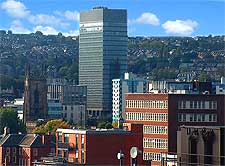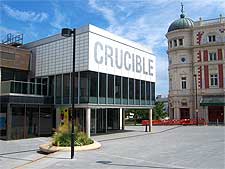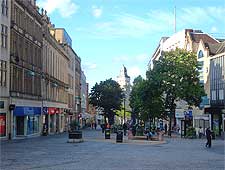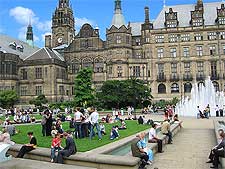Sheffield History Facts and Timeline
(Sheffield, South Yorkshire, England)

Although there's evidence of pre-historic remains in the surrounding area, Sheffield's history can really be said to start with the Anglo Saxons. They established a small village in a forest clearing. Its name is derived from the words 'sheaf' and 'field', which refers to the River Sheaf nearby.
Sheffield was the site of a Norman castle. Founded by William de Lovelot, it became infamous for serving as the prison of Mary, Queen of Scots for some 14 years. Sadly, it did not survive the English Civil War of the 17th century. Indeed, little of the city's medieval architecture survives today.

The Rise of Steel City
The city's close association with cutlery making began in the 15th century. By the early 1600s, the city's reputation as the centre for cutlery production in England was so great that Chaucer even refers to it in 'The Canterbury Tales'.
What allowed Sheffield to become a world leader in the industry was its ability to take advantage of revolutionary advances in metallurgy. From the mid-18th century onwards, these led to great advances in the cutlery production processes used in the city. Crucible steel and silver plating helped to create huge amounts of wealth here - at least for the prosperous steel manufacturers. On the other hand, conditions for most working people were poor, with overcrowding, uncontrolled pollution from factories and foundries, and disease.

The 19th century saw some improvements for those living and working here. Interestingly, this is acknowledged as being the first city in the world to have a football team - Sheffield FC was founded in 1857. New reservoirs were built on the outskirts, helping to combat water-borne diseases. Sadly, this had terrible repercussions when, in 1864, a dam wall collapsed, leading to the Great Sheffield Flood.
Modern Times in History
In 1893, Sheffield was officially recognised as a city. However, there was little to celebrate. In 1937, George Orwell wrote in his book 'The Road to Wigan Pier' that this was the 'ugliest town in the Old World'. Most notable were its slums, thrown up in haste to house a growing population. Even the invention of stainless steel by a Sheffield steel producer in 1913 did little to help the situation.

The outbreak of World War Two was to change the city's fortunes. Its experience in steel production meant that it was to play a vital role in munitions and weapons manufacture. This also made it a prime target for bombing raids, and the Sheffield Blitz left over 40,000 people homeless.
In terms of its industry, the post-war period worked in Sheffield's favour. In particular, surgical blades were in big demand - the city was to produce half of all those made in the world at that time. Renewed prosperity and an opportunity to rebuild the city finally brought an end to Sheffield's notorious slums.
By the 1970s, history shows that the city was starting to struggle once again. Foreign competition in the steel industry led to high unemployment and steel mills closed down in quick succession. It was a sad process that was chronicled during 'The Full Monty' of 1997, a film that featured the lives of unemployed steel workers. Ironically, the film helped to jump start the city's economy. Other Sheffield-based films followed and, today, the city boasts a healthy music and cultural scene. Together, they make up the city's Cultural Industries Quarter.
 Although there's evidence of pre-historic remains in the surrounding area, Sheffield's history can really be said to start with the Anglo Saxons. They established a small village in a forest clearing. Its name is derived from the words 'sheaf' and 'field', which refers to the River Sheaf nearby.
Although there's evidence of pre-historic remains in the surrounding area, Sheffield's history can really be said to start with the Anglo Saxons. They established a small village in a forest clearing. Its name is derived from the words 'sheaf' and 'field', which refers to the River Sheaf nearby.
 The 19th century saw some improvements for those living and working here. Interestingly, this is acknowledged as being the first city in the world to have a football team - Sheffield FC was founded in 1857. New reservoirs were built on the outskirts, helping to combat water-borne diseases. Sadly, this had terrible repercussions when, in 1864, a dam wall collapsed, leading to the Great Sheffield Flood.
The 19th century saw some improvements for those living and working here. Interestingly, this is acknowledged as being the first city in the world to have a football team - Sheffield FC was founded in 1857. New reservoirs were built on the outskirts, helping to combat water-borne diseases. Sadly, this had terrible repercussions when, in 1864, a dam wall collapsed, leading to the Great Sheffield Flood. The outbreak of World War Two was to change the city's fortunes. Its experience in steel production meant that it was to play a vital role in munitions and weapons manufacture. This also made it a prime target for bombing raids, and the Sheffield Blitz left over 40,000 people homeless.
The outbreak of World War Two was to change the city's fortunes. Its experience in steel production meant that it was to play a vital role in munitions and weapons manufacture. This also made it a prime target for bombing raids, and the Sheffield Blitz left over 40,000 people homeless.